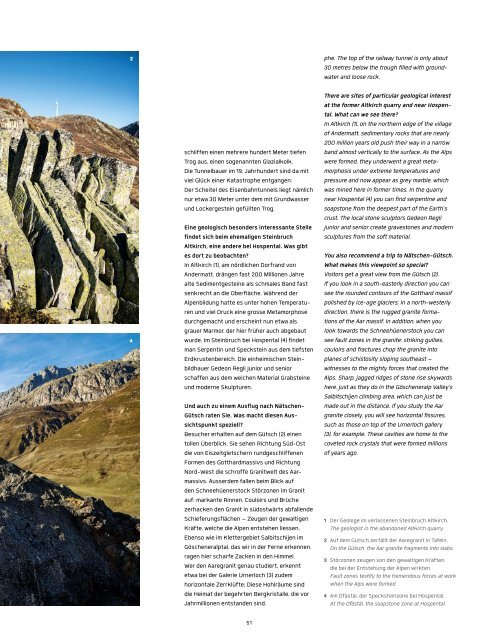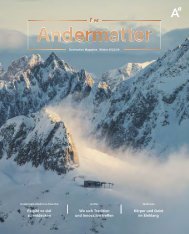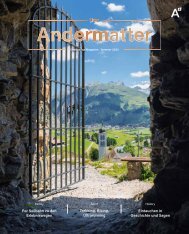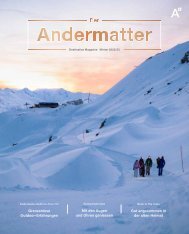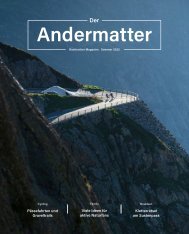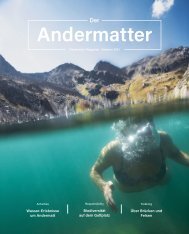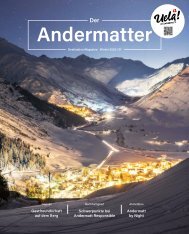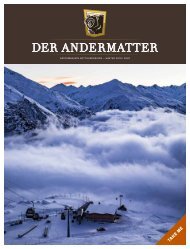Create successful ePaper yourself
Turn your PDF publications into a flip-book with our unique Google optimized e-Paper software.
2<br />
4<br />
schliffen einen mehrere hundert Meter tiefen<br />
Trog aus, einen sogenannten Glazialkolk.<br />
Die Tunnelbauer im 19. Jahrhundert sind da mit<br />
viel Glück einer Katastrophe entgangen:<br />
Der Scheitel des Eisenbahntunnels liegt nämlich<br />
nur etwa 30 Meter unter dem mit Grundwasser<br />
und Lockergestein gefüllten Trog.<br />
Eine geologisch besonders interessante Stelle<br />
findet sich beim ehemaligen Steinbruch<br />
Altkirch, eine andere bei Hospental. Was gibt<br />
es dort zu beobachten?<br />
In Altkirch (1), am nördlichen Dorfrand von<br />
Andermatt, drängen fast 200 Millionen Jahre<br />
alte Sedimentgesteine als schmales Band fast<br />
senkrecht an die Oberfläche. Während der<br />
Alpenbildung hatte es unter hohen Temperaturen<br />
und viel Druck eine grosse Metamorphose<br />
durchgemacht und erscheint nun etwa als<br />
grauer Marmor, der hier früher auch abgebaut<br />
wurde. Im Steinbruch bei Hospental (4) findet<br />
man Serpentin und Speckstein aus dem tiefsten<br />
Erdkrustenbereich. Die einheimischen Steinbildhauer<br />
Gedeon Regli junior und senior<br />
schaffen aus dem weichen Material Grabsteine<br />
und moderne Skulpturen.<br />
Und auch zu einem Ausflug nach Nätschen-<br />
Gütsch raten Sie. Was macht diesen Aussichtspunkt<br />
speziell?<br />
Besucher erhalten auf dem Gütsch (2) einen<br />
tollen Überblick. Sie sehen Richtung Süd-Ost<br />
die von Eiszeitgletschern rundgeschliffenen<br />
Formen des Gotthardmassivs und Richtung<br />
Nord-West die schroffe Granitwelt des Aarmassivs.<br />
Ausserdem fallen beim Blick auf<br />
den Schneehüenerstock Störzonen im Granit<br />
auf: markante Rinnen, Couloirs und Brüche<br />
zerhacken den Granit in südostwärts abfallende<br />
Schieferungsflächen – Zeugen der gewaltigen<br />
Kräfte, welche die Alpen entstehen liessen.<br />
Ebenso wie im Klettergebiet Salbitschijen im<br />
Göscheneralptal, das wir in der Ferne erkennen,<br />
ragen hier scharfe Zacken in den Himmel.<br />
Wer den Aaregranit genau studiert, erkennt<br />
etwa bei der Galerie Urnerloch (3) zudem<br />
horizontale Zerrklüfte: Diese Hohlräume sind<br />
die Heimat der begehrten Bergkristalle, die vor<br />
Jahrmillionen entstanden sind.<br />
51<br />
phe. The top of the railway tunnel is only about<br />
30 metres below the trough filled with groundwater<br />
and loose rock.<br />
There are sites of particular geological interest<br />
at the former Altkirch quarry and near Hospental.<br />
What can we see there?<br />
In Altkirch (1), on the northern edge of the village<br />
of Andermatt, sedimentary rocks that are nearly<br />
200 million years old push their way in a narrow<br />
band almost vertically to the surface. As the Alps<br />
were formed, they underwent a great metamorphosis<br />
under extreme temperatures and<br />
pressure and now appear as grey marble, which<br />
was mined here in former times. In the quarry<br />
near Hospental (4) you can find serpentine and<br />
soapstone from the deepest part of the Earth's<br />
crust. The local stone sculptors Gedeon Regli<br />
junior and senior create gravestones and modern<br />
sculptures from the soft material.<br />
You also recommend a trip to Nätschen-Gütsch.<br />
What makes this viewpoint so special?<br />
Visitors get a great view from the Gütsch (2).<br />
If you look in a south-easterly direction you can<br />
see the rounded contours of the Gotthard massif<br />
polished by ice-age glaciers; in a north-westerly<br />
direction, there is the rugged granite formations<br />
of the Aar massif. In addition, when you<br />
look towards the Schneehüenerstock you can<br />
see fault zones in the granite: striking gullies,<br />
couloirs and fractures chop the granite into<br />
planes of schistosity sloping southeast –<br />
witnesses to the mighty forces that created the<br />
Alps. Sharp, jagged ridges of stone rise skywards<br />
here, just as they do in the Göscheneralp Valley’s<br />
Salbitschijen climbing area, which can just be<br />
made out in the distance. If you study the Aar<br />
granite closely, you will see horizontal fissures,<br />
such as those on top of the Urnerloch gallery<br />
(3), for example. These cavities are home to the<br />
coveted rock crystals that were formed millions<br />
of years ago.<br />
1 Der Geologe im verlassenen Steinbruch Altkirch.<br />
The geologist in the abandoned Altkirch quarry.<br />
2 Auf dem Gütsch zerfällt der Aaregranit in Tafeln.<br />
On the Gütsch, the Aar granite fragments into slabs.<br />
3 Störzonen zeugen von den gewaltigen Kräften,<br />
die bei der Entstehung der Alpen wirkten.<br />
Fault zones testify to the tremendous forces at work<br />
when the Alps were formed.<br />
4 Am Ofästäi, der Specksteinzone bei Hospental.<br />
At the Ofästäi, the soapstone zone at Hospental.


